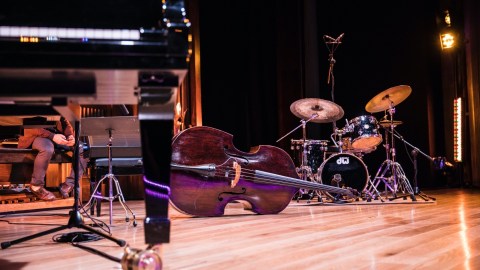Professional musicians are not right-brained

Image source: Dolo Iglesias/Unsplash
- Professional jazz musicians are seen in EEGs as using mostly their left brain hemisphere, which is considered the logical/analytical side.
- The right hemisphere may be more suitable to the sort of creative invention required of people still learning how to play.
- Is the study’s conclusion about jazz, or is it about competence?
The cliché is that creativity happens in the right hemisphere of the brain, while more analytic activities go on in the left. While this isn’t entirely untrue, it’s an over-simplification of how the brain works. In fact, according to a new study from Drexel University’s Creativity Research Lab, expert jazz performers are more likely to use the left side of their brains.

Image source: Kounios, et al
Setting the stage
The study, “Dual-process contributions to creativity in jazz improvisations: An SPM-EEG study,” is published in the journal NeuroImage. It was led by David Rosen of Secret Chord Technology, a new startup that bills itself as “an A.I. software platform that uses advanced analytics based on our globally acclaimed research on the neuroscience of music enjoyment to give you insights that will help you cut through the noise.” In other words, they say they have the ability to predict whether or not people will like a given piece of music, based on neuroscience. It’s an interesting topic in its own right.
For the study, Rosen and Drexel psychology professor John Kounios recorded high-density electroencephalograms (EEGs) from 32 jazz-guitar players. The researchers used EEGs for tracking brain activity because fMRIs more commonly used for neuroscientific investigations of music require participants to be laying down while watching their hand in a mirror as it plays a keyboard — a weak representation of the actual experience of performing.
Some of the players in the study were highly experienced while others were less so, more like students of the form. Speaking of the form, the word and genre “jazz” encompasses a wide range of musics, from Dixieland, to improvisational bebop-based styles, to tightly orchestrated band arrangements, to free-form painting with sound. While the study doesn’t specify what it means by “jazz,” it does quote Miles Davis and Charlie Parker, pointing the discussion firmly in the bebop direction.
Each player was provided lead sheets — simple melody-and-chord notation — for six jazz tunes. They were instructed to improvise for about two minutes around each of these melodies, playing along with pre-recorded drums, bass, and piano accompaniment as their performances were recorded. The 16-bar tunes were constructed to be all of a similar playing difficulty, and they were all at 144 beats-per-minute, a pretty brisk tempo, especially for less experienced players.

Image source: Dominik Scythe/Unsplash
On the right, students. On the left, pros.
Afterward, the recordings were rated by four expert jazz musicians for player categorization, creativity, and other qualities. Combining these ratings with EEG measurements and analysis revealed two things:
- EEG measurements for those performances rated as high-quality (the most competent and professional) indicated that most of the accompanying activity was in the brain’s left hemisphere.
- The less-expert performances were characterized by activity in the right hemisphere.
The study explains pros’ left-brain activity as evidence of their performing in an enhanced state of flow: “This aligns with theoretical models of jazz improvisation which posit that an individual is performing at his or her peak of arousal and ability when entering a flow state.”

Image source: Massimo Sartirama/Unsplash
Another interpretation
“If creativity is defined in terms of the quality of a product, such as a song, invention, poem or painting, then the left hemisphere plays a key role. However, if creativity is understood as a person’s ability to deal with novel, unfamiliar situations, as is the case for novice improvisers, then the right hemisphere plays the leading role.” — John Kounios
Jazz, particularly bebop-based jazz, is a special case in music in at least one key regard, as Kounios’ comment suggests. Improvisation in this type of music is felt by many to be inherently more intellectual than creative, concerned primarily with the strategic — some might say “mathematical” — accurate deployment of existing musical scales and motifs rather than the creation of something genuinely new. Much emphasis in this form is placed on memorization and technique, which fits perfectly well with the study’s left-brain findings. This type of jazz playing may be closer to recitation than creation— its creativity comes in the choices made as to which elements to recite.
For students and less-experienced players, on the other hand, it’s all new, and theirs is much more an experience of genuine right-brained exploration and creativity, as they fumble their way toward understanding the form and learning how to produce its auditory elements. While often less successful for listeners, this is at the heart of creativity: turning bits of the known into something new. Of course their right hemispheres are active.
The professional musician’s brain
For any type of music — perhaps any type of art — it may well be that the experienced performer is always going to be working more from their left hemisphere. Years of practice produces competence, and perhaps more importantly, familiarity, with the material to be performed. There’s little exploring to be done, just competent execution. It can still be fascinating to watch a true musical great perform, their every gesture being forehead-smacking evidence of almost unbelievable skill.
Creativity, though, is its own show, and worthy of appreciation. At a high-school choir concert, for example, there’s little taken for granted: The singers are right there in the moment, on-edge for fear of mistakes, and fully charged-up. It’s nothing short of exciting.
Fortunately, there doesn’t have to be a trade-off between the two. Our greatest musicians never stop pushing at the boundaries of their own skills, repeatedly stranding themselves in the unknown without a map except for an unquenchable thirst for that new, thrilling sound they’ve never before heard.





